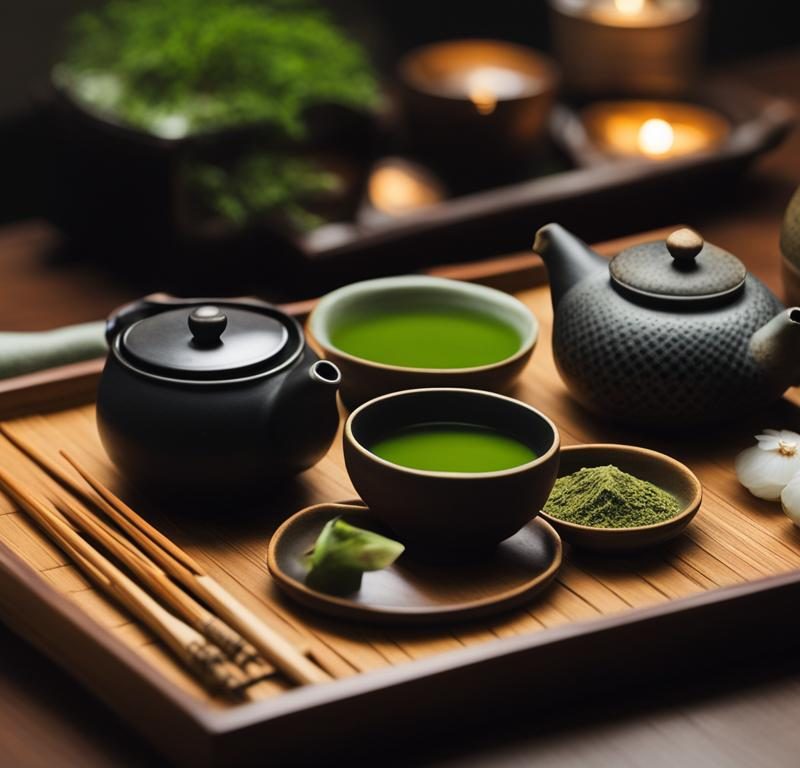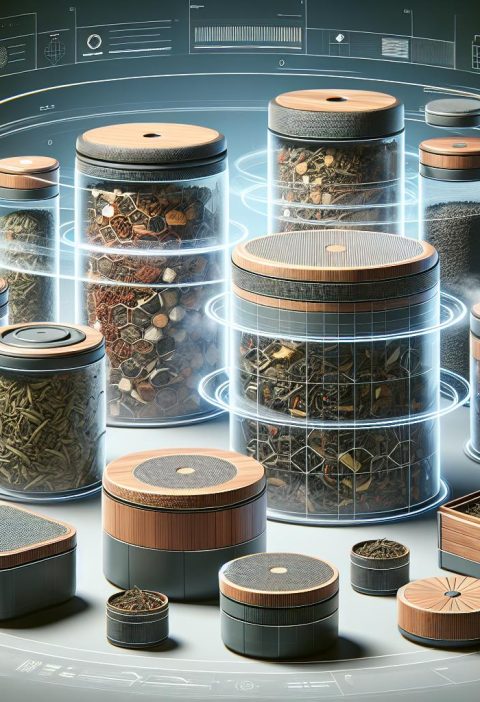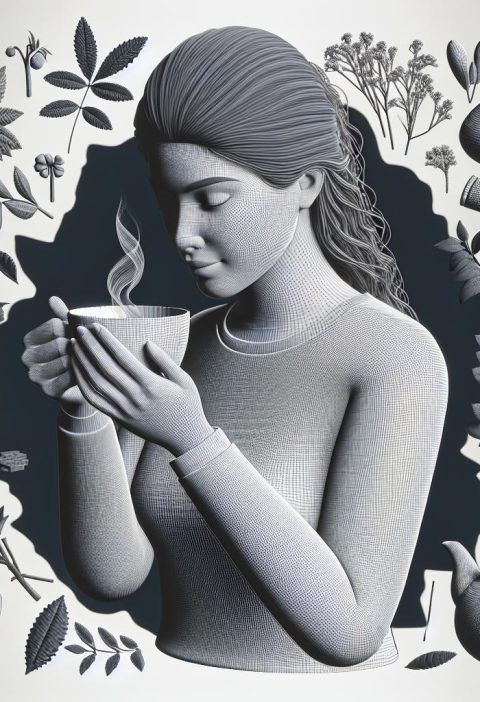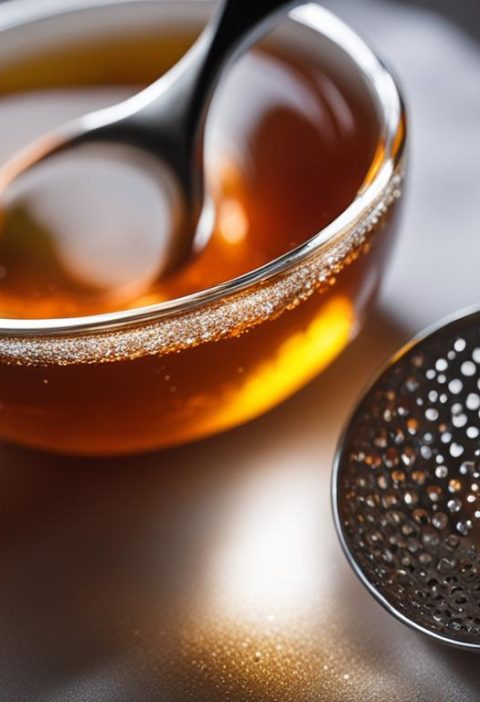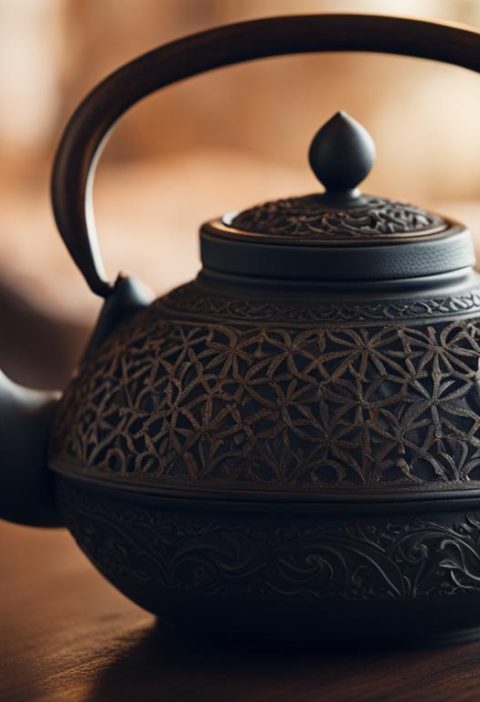The Japanese tea ceremony, known as sadou or chanoyu, is a practice that encapsulates Japanese culture and aesthetics through the art of making and serving matcha. In this guide, we will explore the essential accessories used in a Japanese tea ceremony, including chawan (tea bowls), chasen (tea whisks), and chashaku (tea scoops). These utensils have specific purposes and storied histories, and they play a vital role in the tea ceremony’s rituals and traditions.
Key Takeaways:
- Chawan, or tea bowls, are central to the tea ceremony and come in various styles and shapes, representing the evolving aesthetic tastes of tea practitioners.
- Chasen, or tea whisks, are essential for whisking matcha powder into a foamy texture, with different styles preferred by different tea schools.
- Chashaku, or tea scoops, are used to measure and transfer matcha, and they come in various shapes and styles that vary depending on the tea school and traditions.
- Natsume, or usuchaki, are wooden or lacquered containers used to store and present matcha, with different finishes indicating the formality of the tea ceremony.
- Chaire, or tea containers, are ceramic vessels used to hold high-grade matcha and often paired with precious lids made from ivory or other materials.
Chawan – Tea Bowl
A chawan, or tea bowl, is an essential component of the Japanese tea ceremony. Crafted with meticulous attention to detail, chawan are medium-sized bowls made from glazed stoneware or porcelain. These bowls serve as the focal point of the tea ceremony, as they are used to whisk matcha, offer it to guests, and drink from it, embodying the spirit of harmony, respect, and tranquility.
Chawan come in a wide range of styles and shapes, each representing the evolving aesthetic preferences of tea practitioners and the advancements in Japanese pottery. From the humble Raku bowls known for their rustic charm to the glamorous Tenmoku chawan admired for their breathtaking glazes, each chawan is a work of art that reflects the unique vision and skill of its creator.
One distinguishing feature of a chawan is its “face” or front, known as “shoumen.” The shoumen of a chawan can be predetermined by the potter or carefully chosen by the host to enhance the overall harmony and visual appeal of the tea gathering. This attention to detail highlights the significance of every aspect of the chawan, elevating it beyond a mere vessel to a powerful symbol of artistry and mindfulness.
Chasen – Tea Whisk
A chasen, also known as a tea whisk, is an indispensable tea utensil used to create the frothy and smooth texture of matcha. Crafted from a single piece of bamboo, the chasen consists of delicate tines that efficiently whisk and incorporate the powdered tea with hot water. The intricate design of the chasen allows for the optimal infusion of flavors, ensuring a rich and velvety cup of matcha tea.
The chasen comes in various shapes and sizes, each suited for different types of tea and personal preferences. Some chasen have fewer tines for a more vigorous whisking effect, while others have more tines to create a gentler froth. These variations in design offer tea enthusiasts the flexibility to achieve their desired consistency and texture.
While many chasen are mass-produced today, true connoisseurs seek the authenticity and craftsmanship of chasen made by skilled artisans known as chasen masters. These masters meticulously handcraft each whisk, ensuring the highest level of quality and attention to detail. The artistry and expertise of chasen masters can be witnessed in the precise alignment and delicate curvature of every tine.
Benefits of Using a Chasen:
- Efficiently incorporates matcha powder into hot water
- Achieves a frothy and smooth texture
- Enhances the flavor profile of matcha tea
- Offers flexibility in creating different levels of froth
- Handcrafted by chasen masters for superior quality
Chasen Care and Maintenance:
To ensure the longevity of your chasen, it is essential to properly care for and maintain it. After each use, rinse the chasen with warm water to remove any residual matcha. Gently pat it dry and allow it to air-dry completely. Avoid using soap or harsh detergents, as they can damage the delicate bamboo tines. Store your chasen in a well-ventilated area to prevent mold or mildew growth.
| Chasen Types | Description |
|---|---|
| Bamboo Chasen | The most common and traditional type of chasen, crafted from bamboo. |
| Multi-prong Chasen | A chasen with additional prongs for a more vigorous whisking experience. |
| Wide Prong Chasen | A chasen with wider and thicker prongs for a thicker, more luxurious matcha consistency. |
| Pointed Prong Chasen | A chasen with pointed prongs, ideal for creating a delicate and frothy matcha foam. |
Chashaku – Tea Scoop
In a Japanese tea ceremony, the chashaku, also known as the tea scoop, is an essential utensil used to measure and transfer matcha powder. This elegant tool plays a significant role in accurately portioning the powdered tea and ensuring a consistent and balanced flavor profile.
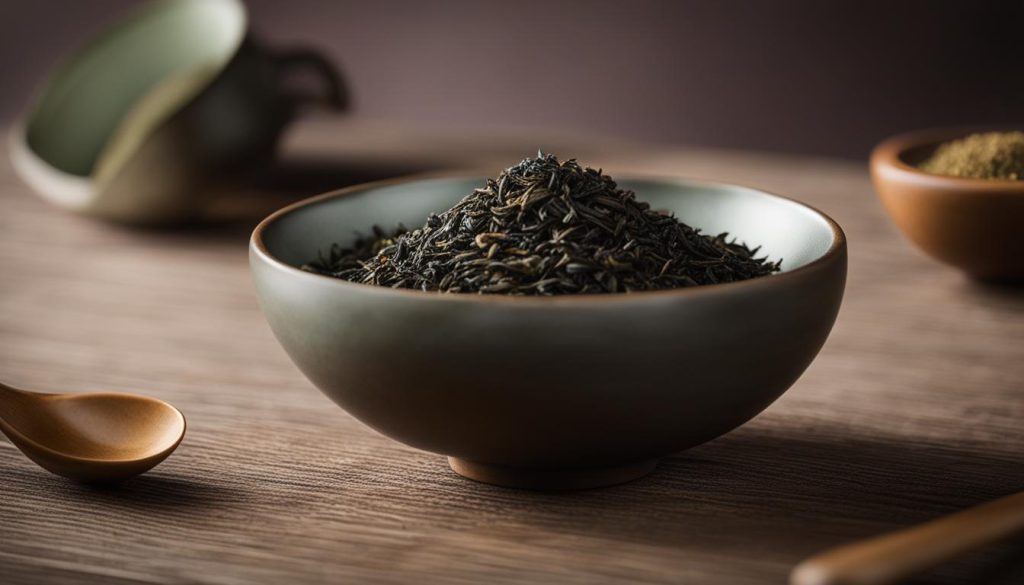
The chashaku is typically made from bamboo or ivory, reflecting the traditional craftsmanship associated with the tea ceremony. While bamboo chashaku are the most common, other materials such as wood, bone, horn, and even glass can also be used, each offering its own unique aesthetic and characteristics.
Chashaku come in various shapes, styles, and sizes, with different designs associated with specific tea schools, seasons, and traditions. This diversity of chashaku styles allows tea practitioners to express their personal aesthetics and preferences within the framework of the tea ceremony.
Historically, tea practitioners would carve their own chashaku, adding a personal touch to this essential utensil. These intricately carved chashaku showcased the skill and creativity of the individual, making each tea scoop a work of art.
Here are some common styles of chashaku:
- Chashaku with a straight shape
- Chashaku with a curved shape
- Chashaku with a pointed tip
- Chashaku with a rounded tip
Each style has its own unique characteristics and is chosen based on the specific tea school, occasion, or personal preference.
Natsume/Usuchaki – Tea Caddy
In the world of Japanese tea ceremony, the natsume or usuchaki holds a special place. These wooden or lacquered wood containers serve as elegant tea caddies, designed to store and present matcha for making usucha or thin tea. The natsume comes in various styles and sizes, each with unique finishes that indicate the formality of the tea ceremony.
Traditionally, natsume were crafted from turned wood and covered with urushi lacquer, which not only enhanced the caddy’s durability but also added a touch of sophistication. However, modern versions of natsume often employ materials like plastic or resin to achieve the same level of functionality. Depending on the occasion and desired atmosphere, natsume can be found in a range of colors and designs.
The most formal natsume are typically undecorated black lacquer, exuding a sense of simplicity and elegance. On the other hand, natsume with different colors or patterns may be used in settings that are slightly less formal. From its origins in traditional Japanese lacquerware to its contemporary adaptations, the natsume remains a cherished and indispensable traditional tea utensil.
| Material | Design | Formality |
|---|---|---|
| Wood | Solid colors | Less formal |
| Lacquered wood | Undecorated black lacquer | Most formal |
| Plastic/resin | Various colors and patterns | Flexible |
Types of Natsume
- Traditional Natsume: Crafted from wood and coated with urushi lacquer, these natsume showcase the timeless beauty of traditional Japanese lacquerware.
- Modern Natsume: Made from plastic or resin, these natsume offer a contemporary twist on the traditional tea caddy, providing greater accessibility and durability.
- Decorative Natsume: Featuring intricate designs and vibrant colors, these natsume serve as decorative pieces that add a touch of artistry to the tea ceremony.
Chaire – Tea Container
Chaire, or tea containers, are ceramic vessels used to hold high-grade matcha for making koicha. These tea containers play a significant role in the Japanese tea ceremony, adding elegance and tradition to the ritual. Chaire come in different shapes and sizes, each with its own name and significance. They are meticulously crafted with attention to detail, showcasing the artistry and craftsmanship of Japanese ceramics.
Traditionally, chaire were paired with lids made from precious materials such as ivory, coated with gold or silver leaf. These lids were believed to protect the tea from poison and were highly valued for their beauty and symbolism. Today, alternative materials like resin, wood, porcelain, and even bone are used for chaire lids.
Antique chaire lids made from ivory or other precious materials are particularly cherished by collectors and enthusiasts due to their historical and artistic value. The use of such lids adds a touch of opulence and rarity to the chaire, elevating them to coveted tea ceremony artifacts.
Chaire in Different Shapes and Sizes
Chaire come in various shapes and sizes, each serving a specific purpose and representing different tea schools or aesthetics. Here are some examples:
- Tsubo: A cylindrical-shaped chaire with a wide body and short neck.
- Mihashira: A chaire with a square cross-section and pillar-like shape.
- Tatebin: A taller chaire with a slim, elongated shape.
These different shapes not only provide visual diversity but can also affect the way the matcha is prepared and presented during the tea ceremony.
Image of Chaire – Tea Container:
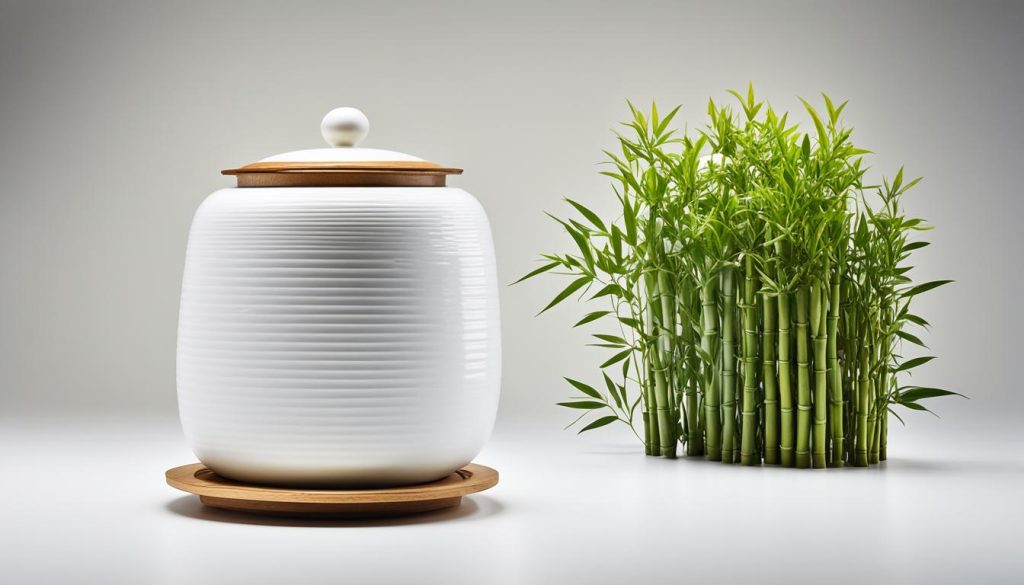
Kama – Kettle
In the Japanese tea ceremony, the kama, or tea kettle, plays a crucial role in heating water for making tea and purifying utensils.
There are two main types of kama used in the tea ceremony:
- Rogama: A cast iron kettle that is placed in a sunken hearth, typically used during colder months.
- Furogama: A portable cast iron kettle that sits atop a charcoal brazier, commonly used in warmer months.
The kama is traditionally heated using high-quality charcoal, which imparts a unique flavor to the water. However, modern tea practitioners also use electric heating elements for convenience and efficiency.
The choice of kama depends on the size of the tea gathering and the resources available. Larger gatherings may require a larger kama, while smaller gatherings can use a more compact one.
| Type of Kama | Function | Materials | Traditionality |
|---|---|---|---|
| Rogama | Placed in a sunken hearth | Cast iron | Traditional |
| Furogama | Sits atop a charcoal brazier | Cast iron | Traditional |
Hishaku – Bamboo Ladle
The hishaku is a crucial utensil used in the Japanese tea ceremony to measure and transfer water. Constructed from bamboo, this ladle plays an essential role in the precision and ritualistic nature of the tea ceremony. Different styles of hishaku are utilized for varying seasons and ceremonies, ensuring that each occasion is marked with the appropriate aesthetic and functionality.
In colder months, the ro hishaku is employed, featuring a larger cup size. This style allows for the transfer of larger quantities of water to accommodate the demands of the tea ceremony during the chilly seasons. Conversely, the furo hishaku, with its smaller cup size, is used in warmer months when lesser amounts of water are required.
Traditional hishaku are traditionally crafted using two pieces of bamboo that are friction-held, showcasing the artistry and ingenuity of Japanese craftsmanship. For increased durability, there are sashi-toshi hishaku available, which have the ladle’s handle passing through the cup and secured in place by a pin. This design ensures that the hishaku is long-lasting and capable of withstanding repeated use.
With its unique design and purpose, the hishaku embodies both practicality and elegance, making it an indispensable part of any tea ceremony. Whether it is used to transfer water for the preparation of matcha or to rinse utensils, the hishaku stands as a symbol of the attention to detail and reverence found within the tea ceremony.
Mizusashi – Fresh Water Container
In the Japanese tea ceremony, the mizusashi serves as a crucial tea utensil, holding fresh water for refilling the kama (tea kettle) and rinsing various utensils. Mizusashi comes in a variety of styles, shapes, and materials, but the most common ones are made of ceramic or lacquered wood. The lid of the mizusashi is typically constructed from the same material as the container itself and can feature simple or intricate decorations.
The mizusashi plays a significant role in not only its practical purpose but also in setting the aesthetic theme for the tea gathering. Alongside the chawan (tea bowl) and natsume/chaire (tea caddy), the mizusashi contributes to creating a harmonious and visually captivating ambiance during the tea ceremony. The choice of mizusashi style can reflect the host’s personal taste, the season, or the overall theme of the event.
Mizusashi Styles
| Style | Description |
|---|---|
| Kamakura Mizusashi | A traditional style with a simple and minimalist design, often made of lacquered wood. |
| Suteteko Mizusashi | A unique style featuring a cylindrical shape and a detachable lid, allowing for easy access to the water. |
| Shinogi Mizusashi | A contemporary style characterized by its angular shape and clean lines, offering a modern aesthetic. |
| Saiki Mizusashi | A classic style inspired by the tea utensils used in the tea rooms of samurai residences. |
Fukusa – Silk Cloth
Fukusa is a square silk cloth that plays a vital role in the Japanese tea ceremony. It is used for the purification of tea utensils, protection of hot kettle lids, and other essential tasks. Made from various types of silk, fukusa is crafted with meticulous care and attention to detail.
The colors of fukusa hold symbolic importance. Traditionally, purple fukusa is used by men, while orange or red fukusa is used by women. These colors represent traditional gender associations and add to the aesthetic beauty of the ceremony. Some tea schools opt for plain fukusa, while others incorporate intricate brocade or pattern designs.
Fukusa is not merely a functional tool, but also a means of demonstrating respect and cleanliness. Its careful use during the tea ceremony reflects the importance of maintaining a pristine environment. Whether using it to cleanse tea utensils or protect precious kettle lids, fukusa contributes to the overall harmonious atmosphere of the tea gathering.
